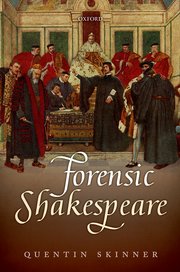Shakespeare In Company by Bart van Es:

This book is about two very different kinds of company. On the one hand it concerns Shakespeare's poet-playwright contemporaries, such as Marlowe, Jonson, and Fletcher. On the other, it examines the contribution of his fellow actors, including Burbage, Armin, and Kemp. Traditionally, criticism has treated these two influences in separation, so that Shakespeare is considered either in relation to educated Renaissance culture, or as a man of the theatre. Shakespeare in Company unites these perspectives. Bart van Es argues that Shakespeare's decision, in 1594, to become an investor (or 'sharer') in the newly formed Chamberlain's acting company had a transformative effect on his writing, moving him beyond the conventions of Renaissance dramaturgy. On the basis of the physical distinctiveness of his actors, Shakespeare developed 'relational drama', something no previous dramatist had explored.
This book traces the evolution of that innovation, showing how Shakespeare responded to changes in the personnel of his acting fellowship and to competing drama, such as that produced for the children's companies after 1599. Covering over two decades of theatrical history, van Es explores the playwright's career through four distinct phases, ending on the conditions that shaped Shakespeare's late style. Paradoxically, Shakespeare emerges as a playwright unique 'in company'—special, in part, because of the unparalleled working conditions that he enjoyed.
Murder Most Foul: Hamlet Through The Ages by David Bevington

What is it about Hamlet that has made it such a compelling and vital work?
Murder Most Foul: Hamlet Through the Ages is an account of Shakespeare's great play from its sources in Scandinavian epic lore to the way it was performed and understood in his own day, and then how the play has fared down to the present: performances on stage, television, and in film, critical evaluations, publishing history, spinoffs, spoofs, musical adaptations, the play's growing reputation, its influence on writers and thinkers, and the ways in which it has shaped the very language we speak. The staging, criticism, and editing of Hamlet , David Bevington argues, go hand in hand over the centuries, to such a remarkable extent that the history of Hamlet can be seen as a kind of paradigm for the cultural history of the English-speaking world.
Forensic Shakespeare by Quentin Skinner
 Forensic Shakespeare
Forensic Shakespeare illustrates Shakespeare's creative processes by revealing some of the intellectual materials out of which some of his most famous works were composed. Focusing on the narrative poem Lucrece, on four of his late Elizabethan plays —
Romeo and Juliet, The Merchant of Venice, Julius Caesar and
Hamlet — and on three early Jacobean dramas,
Othello, Measure for Measure and
All's Well That Ends Well, Quentin Skinner argues that there are major speeches, and sometimes sequences of scenes, that are crafted according to a set of rhetorical precepts about how to develop a persuasive judicial case, either in accusation or defence. Some of these works have traditionally been grouped together as 'problem plays', but here Skinner offers a different explanation for their frequent similarities of tone.
There have been many studies of Shakespeare's rhetoric, but they have generally concentrated on his wordplay and use of figures and tropes. By contrast, this study concentrates on Shakespeare's use of judicial rhetoric as a method of argument. By approaching the plays from this perspective, Skinner is able to account for some distinctive features of Shakespeare's vocabulary, and also help to explain why certain scenes follow a recurrent pattern and arrangement.

No comments:
Post a Comment